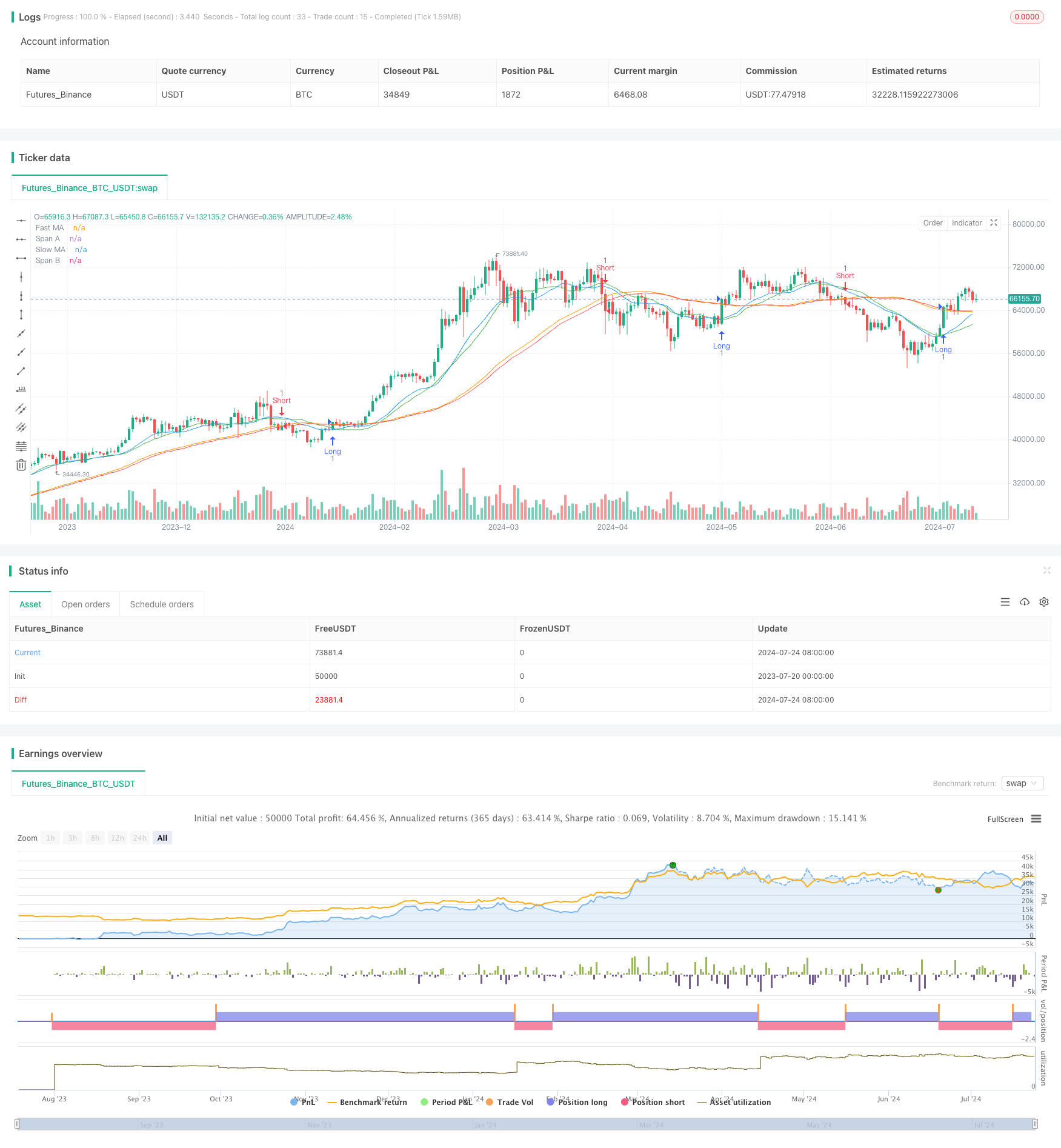
概述
云层动量交叉策略结合均线与成交量确认是一种综合性的交易策略,结合了多个技术指标来识别潜在的交易机会。该策略主要利用一目云图、移动平均线和成交量指标来确定市场趋势和交易信号。策略的核心思想是在价格突破云层的同时,得到移动平均线和成交量的确认,从而增加交易信号的可靠性。
策略原理
一目云图组件:
- 转换线(Conversion Line):9周期的(最高价+最低价)/2的简单移动平均
- 基准线(Base Line):26周期的(最高价+最低价)/2的简单移动平均
- 先行带A(Leading Span A):(转换线+基准线)/2
- 先行带B(Leading Span B):52周期的(最高价+最低价)/2的简单移动平均
移动平均线:
- 快速移动平均线:20周期的收盘价简单移动平均
- 慢速移动平均线:50周期的收盘价简单移动平均
成交量确认:
- 当前成交量超过前一周期成交量的120%
交易信号:
- 做多条件:价格高于先行带A、快速移动平均线和慢速移动平均线,同时满足成交量确认
- 做空条件:价格低于先行带A、快速移动平均线和慢速移动平均线,同时满足成交量确认
策略优势
多重确认:结合了一目云图、移动平均线和成交量三个维度的确认,提高了交易信号的可靠性。
趋势跟踪:利用一目云图和移动平均线可以有效捕捉中长期趋势,减少假突破。
灵活性:通过调整各个指标的参数,可以适应不同的市场环境和交易品种。
成交量确认:加入成交量确认可以过滤掉一些虚假的突破信号,提高交易的成功率。
可视化:一目云图和移动平均线都可以直观地在图表上展示,便于交易者快速判断市场状况。
策略风险
滞后性:所有使用的指标都具有一定的滞后性,可能导致在快速变化的市场中错过一些交易机会。
假突破:尽管使用了多重确认,但在震荡市场中仍可能出现假突破信号。
参数敏感性:策略的表现可能对参数设置较为敏感,需要进行充分的回测和优化。
过度交易:在某些市场条件下,可能会产生过多的交易信号,增加交易成本。
市场适应性:该策略可能在趋势明显的市场中表现更好,而在震荡市场中效果可能不佳。
策略优化方向
动态参数调整:可以考虑根据市场波动率动态调整指标参数,以适应不同的市场环境。
加入止损和止盈:引入适当的止损和止盈机制,可以更好地控制风险和锁定利润。
时间过滤:可以加入时间过滤器,避免在市场开盘和收盘等波动较大的时间段进行交易。
趋势强度确认:可以引入ADX等趋势强度指标,只在趋势足够强时才进行交易。
多时间周期分析:结合更长的时间周期进行分析,以提高交易信号的可靠性。
加入其他技术指标:如RSI或MACD,进一步确认交易信号。
资金管理优化:根据不同的市场条件和信号强度,动态调整仓位大小。
总结
云层动量交叉策略结合均线与成交量确认是一个综合性的交易系统,通过结合一目云图、移动平均线和成交量指标,提供了一个相对可靠的交易框架。该策略的优势在于多重确认机制和趋势跟踪能力,但也面临着指标滞后和参数敏感性等挑战。通过进一步的优化,如动态参数调整、加入止损止盈机制和多时间周期分析等,可以增强策略的稳健性和适应性。交易者在使用此策略时,需要充分了解其原理和局限性,并根据具体的交易品种和市场环境进行适当的调整和优化。
/*backtest
start: 2023-07-20 00:00:00
end: 2024-07-25 00:00:00
period: 1d
basePeriod: 1h
exchanges: [{"eid":"Futures_Binance","currency":"BTC_USDT"}]
*/
//@version=5
strategy("Ichimoku Clouds Strategy with Moving Averages and Volume Confirmation", overlay=true)
// Define input variables
conversion_period = input.int(9, title="Conversion Line Period")
base_period = input.int(26, title="Base Line Period")
span_b_period = input.int(52, title="Span B Period")
displacement = input.int(26, title="Displacement")
fast_ma_length = input.int(20, title="Fast MA Length")
slow_ma_length = input.int(50, title="Slow MA Length")
volume_threshold_percent = input.float(20, title="Volume Threshold (%)")
// Calculate Ichimoku Clouds
conversion_line = ta.sma((high + low) / 2, conversion_period)
base_line = ta.sma((high + low) / 2, base_period)
span_a = (conversion_line + base_line) / 2
span_b = ta.sma((high + low) / 2, span_b_period)
// Plot Ichimoku Clouds
plot(span_a, color=color.blue, title="Span A")
plot(span_b, color=color.red, title="Span B")
// Calculate moving averages
fast_ma = ta.sma(close, fast_ma_length)
slow_ma = ta.sma(close, slow_ma_length)
// Plot moving averages
plot(fast_ma, color=color.green, title="Fast MA")
plot(slow_ma, color=color.orange, title="Slow MA")
// Volume condition
volume_confirmation = volume > volume[1] * (1 + volume_threshold_percent / 100)
// Entry conditions
long_condition = close > span_a and close > fast_ma and close > slow_ma and volume_confirmation
short_condition = close < span_a and close < fast_ma and close < slow_ma and volume_confirmation
if (long_condition)
strategy.entry("Long", strategy.long)
if (short_condition)
strategy.entry("Short", strategy.short)